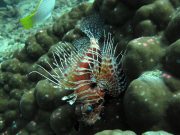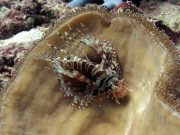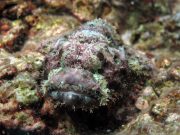Tauchen mit Skorpionfisch & Feuerfisch
Meeresleben von Lanta | Scorpaenidae
Die Skorpionfische sind eine große Familie giftiger Fische, zu denen auch der Feuerfisch, der Steinfisch, der Wespenfisch und der Samtfisch gehören. Sie sind an jedem Tauchplatz auf Koh Lanta Tauchausflügen zu finden.
Unter Tauchern bezieht sich das Wort Skorpionfisch im Allgemeinen auf die Gattung Scorpaenopsis, und hier schließen wir auch die Unterfamilie Pteroinae ein, zu der auch der Feuerfisch gehört. Mitglieder dieser Gruppe haben Kämme und/oder Stacheln auf dem Kopf, einen oder zwei Stacheln auf dem Kiemendeckel, Stacheln an der unteren Wange und 11 bis 17 Stacheln auf der Rückenflosse.
Wie der Name schon sagt, haben Skorpionfische eine Art 'Stachel' in Form von scharfen Stacheln, die mit giftigem Schleim überzogen sind. Die Brustflossen sind gut entwickelt, und die Stacheln der Rücken-, Bauch- und Afterflossen haben alle Giftdrüsen an ihrer Basis. Diese Stacheln können einen giftigen Stich verursachen, der tagelang anhalten und extreme Schmerzen, Schweißausbrüche, Atemnot und sogar Lähmungen hervorrufen kann.
Die meisten Arten sind Bodenbewohner, ernähren sich von Krebstieren und kleineren Fischen und gelten als nachtaktive Jäger, die ihre Beute aus dem Hinterhalt fangen, wenn sie vorbeischwimmt, und sie dann ganz verschlingen. Feuerfische verfügen über spezielle Schwimmblasenmuskeln, die ihnen eine hervorragende Kontrolle ermöglichen, sodass sie ihren Schwerpunkt verändern können, um besser angreifen zu können.
6 Arten auf dieser Seite gefunden:
Mombasa Lionfish
(Pterois mombasae)

Pterois mombasae @ Koh Haa
The mombasa lionfish, or african lionfish, grows to 16 cm. The body comprises reddish brown stripes with alternating broad and thin dark bars separated with white stripes. This species has a dark spot on the cheek and whitish fan-like pectoral fins with semicircular bands formed of large spots and long filamentous rays.
The mombasa lionfish is solitary and can normally be found in areas with soft corals, sponges, rubble and soft-bottomed areas of sheltered reefs.
Indian Lionfish
(Pterois miles)

Pterois miles @ Koh Bida
The Indian Lionfish has a white body, with numerous creamy-red or reddish-brown vertical stripes. The vertical stripes alternate from wide to very thin and sometimes merge to form a V-shape. The head has fleshy antenna and numerous fleshy appendages.
The dorsal fin spines are highly venomous and can inflict excruciatingly painful puncture wounds. The pectoral fins are wing-like with separate broad, smooth rays.
This species grows to 35 cm and is very similar to, and often confused with the red lionfish (Pterois volitans). The Red Lionfish is native to the Gulf of Thailand, and the Indian Lionfish is native to the Andaman Sea. The Red Lionfish (Gulf of Thailand) has more dorsal and tail fin rays than the Indian Lionfish.
Juveniles have black stripes and bars.
Clearfin Lionfish
(Pterois radiata)

Pterois radiata @ Koh Haa
The Clearfin Lionfish body has wide brown to reddish brown bars with white bars between them. Two white lines make a horizontal band on the tail base.
The thin white pectoral fin spines are quite long compared to other species and have no markings. The pectoral fin rays are thin and reddish brown.
The Clearfin Lionfish grows to 24 cm and is nocturnal, emerging at night to feed on invertebrates such as crabs and shrimps.
This species is not commonly seen around the Lanta dive sites.
Zebra Lionfish
(Dendrochirus zebra)

Dendrochirus zebra @ Koh Haa
The zebra lionfish has a reddish body with 5 vertical stripes, usually orangish/black, with white spacing and grows to a maximum size of around 25 cm.
There may be alternating thin dark bars in larger individuals. The pectoral fins are large, fan-like and flare out on either side of the fish. The pectoral fins are banded dark reddish/orange and white.
This species also has a dark brown band through the eye, a large black spot on the cheek, and pale and dark bands on the dorsal-fin spines. The dorsal fin has thirteen venomous spines along its back, connected with a clear film-like membrane.
The zebra lionfish live near the sea bed, found on coral, rubble, and rock bottoms on reef flats and lagoons. This species may also be found in caves, or other dark areas under corals or inside a shipwreck, sometimes in small groups. These fish are generally slow-moving and peaceful, but can be dangerous when disturbed or attacked. The zebra lionfish feeds on small crustaceans, and is in turn preyed upon by groupers.
Bearded Scorpionfish
(Scorpaenopsis barbata)

Scorpaenopsis barbata @ Koh Bida
The bearded scorpionfish grows to 25 cm in length and is usually brightly coloured and heavily camouflaged. The body is normally dark brown or reddish in colour, with many blackish and whitish blotches. Often the bearded scorpionfish will have darker area starting behind the lower part of the eye and extending down toward the lower cheek.
This species has many fleshy outgrowths of skin protruding from the chin, giving a beard-like appearance. The space between the eyes has several ridges created by spines, and these are separated by a channel which is more than double the width of a ridge. This fish also has a moderately deep cavity in the rear portion of the upper surface of the skull, known as the occipital pit.
Often confused with the tassled scorpionfish (Scorpaenopsis oxycephala) which has a much longer snout that the bearded scorpionfish, these ambush predators usually rest during the day, feeding at night on crustaceans and other small fishes.
Devil Scorpionfish
(Scorpaenopsis diabolus)

Scorpaenopsis diabolus @ Koh Bida
The devil scorpionfish can usually be found on the seabed, on sand or gravel areas. This fish has a broad head with a wide mouth, a noticeably humped back, and a tapering body, and can reach 30 cm.
The snout length is around 1.3 to 1.5 times the diameter of the eye and this measurement can help to distinguish this species from other, similar species.
Devil scorpionfish have rough skin and numerous projections, spines, and tassels which aid with camouflage.
Colouring can be changed quickly to aid camouflage, but is typically a combination of grey and white with reddish-brown blotches. The inside of the pectoral fins are banded orange and white, with black blotches.
Tauchen mit Skorpionfisch & Feuerfisch rund um Koh Lanta
Tauch- und Schnorchelausflüge
Wenn Sie gerne die Gelegenheit hätten, Skorpionfisch & Feuerfisch auf einem unserer täglichen Tauchausflüge während der Hochsaison von Koh Lanta aus zu sehen, dann senden Sie uns eine E-Mail an info@diveandrelax.com.
Nehmen Sie an unseren Speedboot-Tauchausflügen in der Hochsaison zu einigen der besten Tauchplätze Thailands teil und genießen Sie kleine Gruppen, kurze Fahrzeiten und einen Fokus auf hervorragenden persönlichen Service, Sicherheit und Spaß.
Noch kein zertifizierter Taucher? Lernen Sie auf Koh Lanta das Tauchen mit dem 3-tägigen SSI Open Water Diver Kurs.
Buchen Sie online und sparen Sie 10% auf Tauchausflüge und Tauchkurse auf Koh Lanta.
Weitere Informationen
Indo-Pazifische Meereslebewesen-Führer
- Allen, G., Steene, R., Humann, P., DeLoach, N. (2003) Reef Fish Identification, Tropical Pacific. Jacksonville, FL., USA: New World Publications, Inc., ISBN 1-878348-36-1.
- Humann, P., DeLoach, N., (2010) Reef Creature Identification, Tropical Pacific. Jacksonville, FL., USA: New World Publications Inc., ISBN 978-1-878348-44-9
- Debelius, H. (2013) Indian Ocean Reef Guide. Frankfurt, Germany: IKAN - Unterwasserarchiv, ISBN 978-3-939767-52-7.
- Debelius, H. (2004) Nudibranchs and Sea Snails, Indo-Pacific Field Guide. Frankfurt, Germany: IKAN - Unterwasserarchiv, ISBN 3-925919-51-1
- Erhardt, H., Knop, D. (2015) Corals Indo-Pacific Field Guide. Frankfurt, Germany: IKAN - Unterwasserarchiv, ISBN 3-925919-69-4.
- Veron J.E.N., Stafford-Smith M.G., Turak E. and DeVantier L.M. (2016). Corals of the World
Weitere Referenzen zu Meereslebewesen und weitere Informationen
